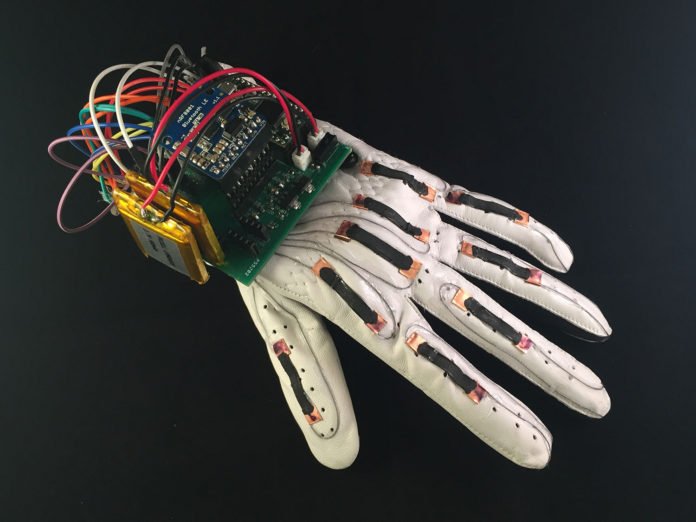A team of student from California University San Diego developed a new low-cost smart glove especially for the people in the deaf community. This new glove wirelessly translates the American Sign Language alphabet into text and controls a virtual hand to mimic sign language gestures. It can convert the 26 letters of American Sign Language (ASL) into text on a smartphone or computer screen.
Scientists named the device as ‘The Language of Glove’, built for less than $100 using stretchable and printable electronics.
Jesal Vishnuram, the technology research manager at the charity Action on Hearing Loss said, “For thousands of people in the UK, sign language is their first language. Many have little or no written English. Technology like this will completely change their lives.”
This low-cost smart glove is unique in that. It has sensors made from stretchable materials, is inexpensive and simple to manufacture. The device consists of a standard sports glove kitted out with nine flexible strain sensors that are placed over different knuckles. When a user bends their fingers or thumb, the sensors stretch, and their electrical resistance goes up. The software uses these signals to work out the configuration of the hand.
The sensors inside the glove are made of thin strips of a silicon-based polymer coated with a conductive carbon paint. They are secured onto the glove with copper tape and connected with stainless steel thread at a low power, custom-made printed circuit board.
When the user stretches or bends the glove, sensors change their electrical resistance. This allows them to code for different letters of the American Sign Language alphabet based on the positions of all nine knuckles. A straight or relaxed knuckle is encoded as “0” and a bent knuckle is encoded as “1”.
When signing a particular letter, the glove creates a nine-digit binary key that translates into that letter. For example, the code for the letter “A” (thumb straight, all other fingers curled) is “011111111,” while the code for “B” (thumb bent, all other fingers straight) is “100000000.” Engineers equipped the glove with an accelerometer and pressure sensor to distinguish between letters like “I” and “J”, whose gestures are different and generate the same nine-digit code.
The circuit board integrated inside it, converts the nine-digit key into a letter and then transmits the signals via Bluetooth to a smartphone or computer screen. In this way, the glove wirelessly transmits all 26 letters of the American Sign Language alphabet into text.
Timothy O’Connor, a nanoengineering Ph.D. student at UC San Diego said, “Gesture recognition is just one demonstration of this glove’s capabilities. Our ultimate goal is to make this low-cost smart glove that in the future will allow people to use their hands in virtual reality, which is much more intuitive than using a joystick and other existing controllers. This could be better for games and entertainment, but more importantly for virtual training procedures in medicine, for example, where it would be advantageous to actually simulate the use of one’s hands.”
Darren Lipomi, a nanoengineering professor who is a member of the Center for Wearable Sensors at UC San Diego, “We’ve innovated a low-cost and straightforward design for smart wearable devices using off-the-shelf components. Our work could enable other researchers to develop similar technologies without requiring costly materials or complex fabrication methods.”
